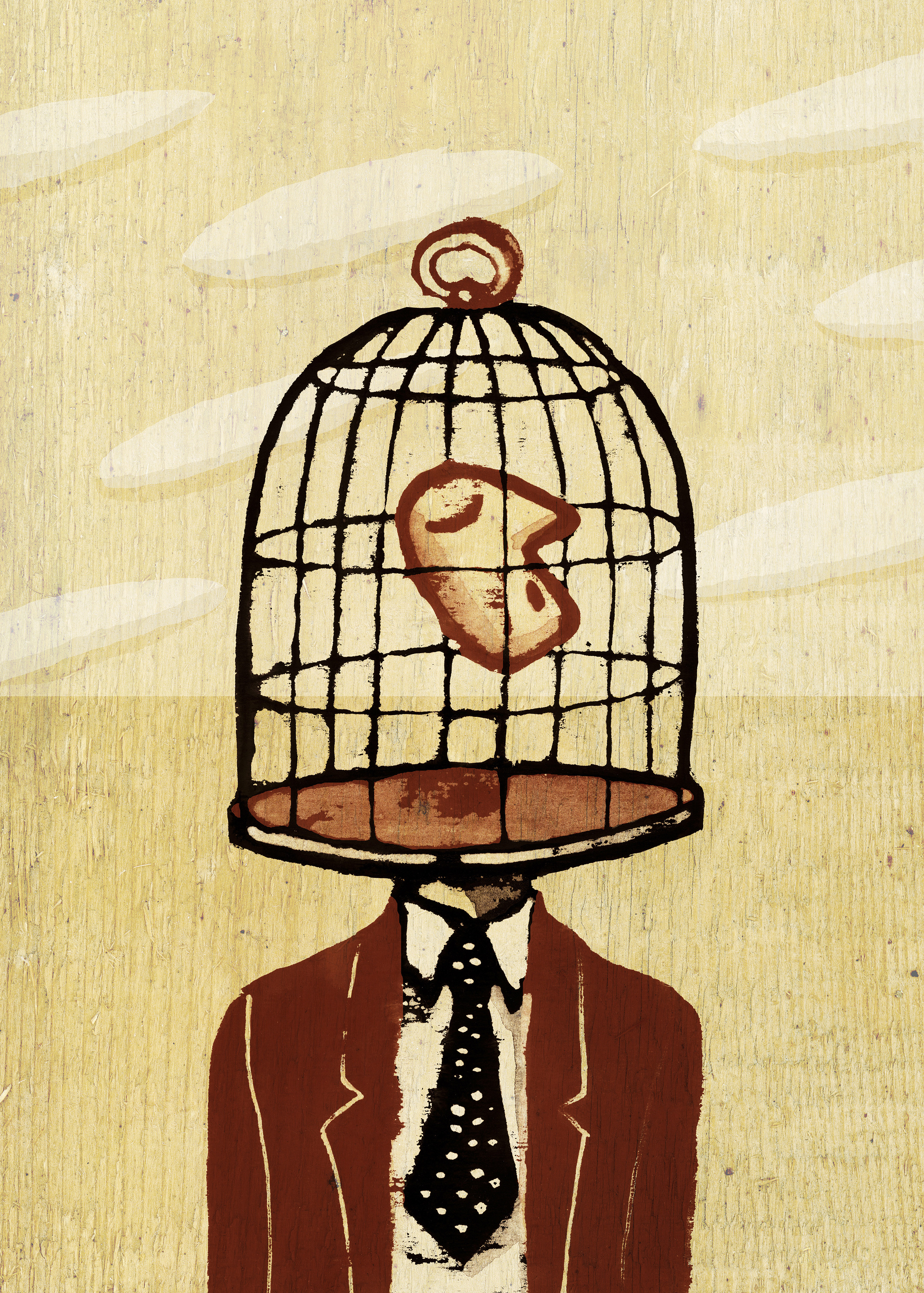How the internet trapped us inside our own heads
A review of Matthew B. Crawford's The World Beyond Your Head


Imagine for a moment the reaction of someone from a different era to a front-page story from last Sunday's New York Times — the one titled (in the print edition), "Abuse of Attention Deficit Pills Graduates Into the Workplace."
This person would learn from the article that large numbers of early 21st-century American children have trouble attending to their schoolwork, and that to address this problem we medicate them with stimulants. Next this reader would learn that some of these kids, and many others with no diagnosable condition, go on to use and abuse the pills in college — and that the trend has now extended into people's careers, allowing them to work absurdly long hours, late into the night and on into the morning, all in order to achieve unnatural levels of productivity, which they think necessary to secure positive evaluations and promotions in their jobs. Finally, there are the other pharmaceuticals — the sedatives and anti-depressants — that these people often need to help them fend off the resulting waves of exhaustion, anxiety, and depression.
Is there any doubt that this imagined reader from another time and place would conclude that something had gone terribly wrong in our world?
The Week
Escape your echo chamber. Get the facts behind the news, plus analysis from multiple perspectives.

Sign up for The Week's Free Newsletters
From our morning news briefing to a weekly Good News Newsletter, get the best of The Week delivered directly to your inbox.
From our morning news briefing to a weekly Good News Newsletter, get the best of The Week delivered directly to your inbox.
Strangely, though, we seem not to be especially fazed by the news. How could it be that we find it unremarkable that large numbers of us feel driven to ingest vast quantities of behavior- and mood-altering chemicals, turning us into preternaturally efficient, drug-addled workaholics?
Short of hopping into a time machine to gain much-needed perspective on the madness of the present cultural moment, Americans might consider spending a few evenings with Matthew B. Crawford's The World Beyond Your Head: On Becoming an Individual in an Age of Distraction, the most cogent and incisive book of social criticism I've read in a long time. Reading it is like putting on a pair of perfectly suited prescription glasses after a long period of squinting one's way through life. Objects vaguely detected but imperfectly perceived suddenly come into focus, taking on newfound shape and clarity.
Those who dipped into Crawford's previous book, the improbable 2009 bestseller Shop Class as Soulcraft, will recognize the approach. Crawford, who fabricates components for custom motorcycles when he isn't writing books, will typically start a chapter with an anecdote about some peculiar facet of modern life illuminated by a quote from Hobbes or a contemporary anthropologist. The quote is then used to introduce an absorbing account of some activity involving skilled craftsmanship (motorcycle repair, for example, or jazz improvisation), with all of it culminating in a sweeping (but also nuanced) indictment of how we think about life and love, beauty and work. Like the earlier book, The World Beyond Your Head is intended to be both diagnostic and prescriptive — first, highlighting unhappy aspects of our lives that we half-notice but don't adequately attend to, then suggesting ways of reforming them that will enable us more fully to flourish as individuals.
It's a style of writing that manages to be accessible, demanding, and rewarding — but also exceedingly difficult to summarize.
A free daily email with the biggest news stories of the day – and the best features from TheWeek.com
The World Beyond Your Head begins with a haunting evocation of how we are increasingly barraged by technologically facilitated sensory stimulation. We live in "a culture saturated with technologies for appropriating our attention," in which "our interior mental lives are laid bare as a resource to be harvested" — harvested by our friends, acquaintances, colleagues, bosses, and above all, corporations using the latest advances in cognitive science to market their products through ever-more effective and omnipresent forms of advertising.
Crawford sees this swirl of stimulation as growing out of a vision of human beings bequeathed to us by a certain strand of Enlightenment and liberal thinking — specifically the strand that wends its way from Rene Descartes down to John Locke and (especially) Immanuel Kant, the last of whom held out an influential ideal of the individual as an autonomous rational being whose will is unconditioned by anything external to it.
In one of the most entertaining and illuminating chapters in the book, Crawford exposes the pervasiveness of this Kantian ideal in our world by offering, of all things, a critical interpretation of the Disney Channel's popular children's program Mickey Mouse Clubhouse. In earlier iterations of the show, back in the middle decades of the 20th century, the show entertained kids with slapstick and acrobatics in which beloved Disney characters (Mickey Mouse, Goofy, Donald Duck) interacted (sometimes a little violently) with a recalcitrant physical world.
In our time the show has been radically re-imagined. Computer animation now places the characters in a virtual world in which any conceivable problem they confront is easily solved by a computer (the Handy Dandy machine) that is instantly summoned at any time and place. "Oh, Tootles!" Mickey and his friends exclaim, and up pops a screen, providing ready-made solutions perfectly tailored to any random obstacle or frustration that temporarily stands in the way of achieving their goal in a given episode.
In Crawford's telling, this is our world — or at least the world our culture is scrambling to create. It's one in which there will supposedly be "no conflict between self and world" and "no contingency that hasn't been anticipated by the Handy Dandy machine" in our home, in our workplace, in our car, in our pocket or purse. This machine (our computers, our phones) makes us feel like Kant's autonomous rational being by constructing "enthralling representations" (websites, handles, avatars, profiles, anonymous accounts) "that save us from a direct confrontation with the world." Instead, we withdraw into "a little ‘me-world' of manufactured experience" — a world filled with "hyperpalatable mental stimuli" (the cognitive equivalent of junk food) — in comparison to which "the world of regular old experience may come to seem not only frustrating but unbearably drab."
But of course no one can be truly, completely autonomous. The person walking down the street with his eyes fixed on (and his mind lost in) his phone is still moving through a real, physical world filled with objects and obstacles that threaten to thwart his will with every step. (Watch out for the bus!) This jarring disconnect between the virtual worlds that increasingly absorb our minds and the physical, natural world in which our bodies still reside produces, on Crawford's telling, a range of unintended consequences.
One of these consequences is the emergence of a "culture of performance," in which ostensibly autonomous individuals ruthlessly compete (in school, in the workplace, in the pursuit of friends, lovers, and spouses) for recognition and reward. It's this competition that drives growing numbers of young people to dose up on Adderall in the hope of overcoming physical limits on the human capacity to work, and many others to be plagued by anxiety at the prospect of failure — an anxiety that culminates far too often in depression.
But the worst consequence can be seen in slot-machine gambling, which Crawford examines in an especially chilling chapter that treats addiction to such games as a kind of dystopian end point for our culture. As the world devoted to granting us complete autonomy becomes, paradoxically, increasingly confusing and overwhelming, with the experience of genuine agency ever-more elusive, millions of our fellow citizens have begun behaving like highly functional autistics — choosing, in the greatest irony of all, to surrender completely to manipulation by the "gaming industry."
In pursuit of profit, this industry provides a highly structured "zone of autistic pseudo-action" that is "sealed off from the world" and experienced as that rarest of things, a place of genuine "efficacy and intelligibility." This virtual place requires nothing beyond the capacity to press a button, unthinkingly, over and over again, while the game delivers a precisely calibrated combination of wins and losses to ensure maximal addiction. It is not uncommon for the gaming addict to urinate or defecate on herself as she falls deeper and deeper into the zone over 10, 12, 14 hours of uninterrupted play, until every last dollar is gone.
The gambling industry describes this, revealingly, as "playing to extinction."
Against this unsettling vision of our present and future, Crawford draws on Hegel, Tocqueville, Heidegger, Freud, and Kierkegaard to sketch an alternative account of human culture and individuality — one that rejects the ideal of autonomy in favor of embedding oneself in concrete social practices and traditions.
Note that Crawford is not making the case for uncritically accepting any particular tradition. He's not a reactionary. What he has in mind is a "dialectic with tradition" in which a person makes slow progress toward excellence through apprenticeship, obeying the authority of a highly skilled teacher or guide, showing a willingness to follow strict rules, and only much later learning to improvise and make incremental contributions to improving the tradition.
The book is filled with examples of such embedded activities, most of them involving a team of people contributing to a common enterprise: the short-order cook, the hockey player, the motorcycle racer, the glass blower, the pipe-organ maker. All are activities in which a skilled practice is inherited — and the inheritance is "experienced not as a burden but as a source of energy" fueling individual creativity. This isn't the kind of autonomous creativity we associate with Silicon Valley icons like Steve Jobs, who (the story goes) lock themselves in a garage conjuring brilliant sui generis inventions out of nothingness, like God creating the universe. That's a vision of creativity as something "irrational, incommunicable, unteachable."
Against this, Crawford champions a "highly situated self-understanding," in which the excellence people reach for in their work genuinely "expresses their individuality" and grows out of an intimate encounter and interaction with both the cultural world we inherit as well as the physical world around us. Crawford insists that such a way of living and working can help us to "reclaim the real," "inspire wonder and gratitude," draw us "out of ourselves toward beauty," and even form the basis for a "this-worldly ethics of attention."
Those are high hopes. Is it possible for us to fulfill them? Sure. Probable? I'd say no. But that shouldn't take anything away from Crawford's powerful and compelling call to reengage with the world beyond our heads.
Damon Linker is a senior correspondent at TheWeek.com. He is also a former contributing editor at The New Republic and the author of The Theocons and The Religious Test.



